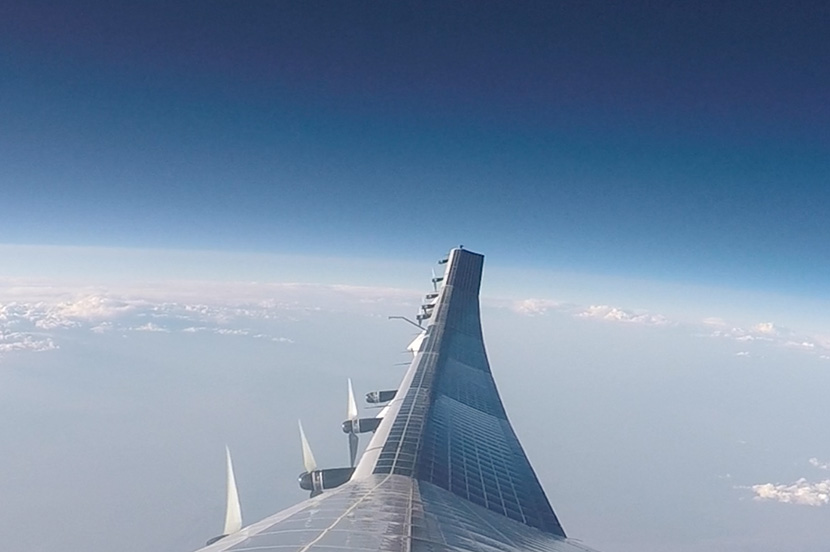
HAPSMobile Inc., a SoftBank Corp. (TOKYO: 9434) subsidiary launched in 2017 with the mission of bridging the digital divide, marked two major milestones on September 21, 2020. First, the solar-powered, unmanned aircraft “Sunglider” took flight in the stratosphere for the first time. Second, Sunglider also successfully delivered an LTE connection from the stratosphere during the flight, marking a world first for a fixed-wing High Altitude Platform Station (HAPS) autonomous aircraft.
With a communications payload under its wing, Sunglider functions like a base station floating in the sky. Circling the stratosphere above the earth, it transmits radio waves down to mobile phones on the ground. This means it can reach areas where it is difficult to build infrastructure, including remote areas and developing countries. Since it flies in the stratosphere and is therefore unaffected by weather on the ground, Sunglider can also deliver connectivity when disasters strike.
While the concept may seem far out--in fact, HAPSMobile President & CEO Junichi Miyakawa was originally inspired by the Japanese fantasy anime classic “Castle in the Sky” before launching the business--HAPSMobile’s landmark flight and communication tests have shown that it is making great progress on its mission to connect the unconnected, which now accounts for roughly half of the world’s population.

Learn more about why SoftBank decided to launch HAPSMobile and how HAPS technology works in this in-depth article.
Sunglider withstands the extremes of the stratosphere
Together with its development partner AeroVironment, Inc., HAPSMobile began developing Sunglider in 2017. Since then it has conducted a number of test flights, first at NASA’s Armstrong Flight Research Center in 2019, and then at Spaceport America in New Mexico in 2020. Over the course of its four test flights, Sunglider’s flight times and altitudes have steadily increased.
On its fifth test flight on September 21, 2020 at Spaceport America, Sunglider reached the stratosphere for the very first time, reaching a maximum altitude of 62,500 feet (approximately 19 kilometers). The test flight lasted for more than 20 hours, and more than 5 of them were spent in the stratosphere.
To develop and fly an unmanned aircraft in the short space of three years is a remarkable feat of engineering in the industry. President & CEO Junichi Miyakawa remarked that the test represented a successful step forward. He described the demanding conditions, “Even though the temperature fell below 73 degrees Celsius, our work on endurance tests bore fruit and resulted in a successful test flight. On the day of the test, Sunglider faced aerial currents of roughly 30 meters per second, so I was relieved when it hit the runway after clearing all test items.”
Watch Sunglider’s historic stratospheric flight test here.
Two “Fathers of the Internet” join historic video call enabled by HAPS aircraft
In addition to the stratospheric flight test, an important milestone was reached with the successful test of the communications payload. Jointly developed with strategic partner Loon LLC --a subsidiary of Alphabet, the parent company of Google--the payload delivered a stable LTE connection for 15 hours during the test flight. Despite the demanding conditions of the stratosphere, the communications payload transmitted radio waves as expected to the team on the ground at Spaceport America. This enabled a video call with participants joining from New Mexico (Spaceport America), Tokyo, Mountain View, California and Washington, D.C.
Notably, team members based at Spaceport America used regular smartphones to join the video call. Unlike with satellite communications, which require special handsets, HAPS works with the frequencies used by smartphones now on the market.

Test system diagram
On the video call were two luminaries that are widely recognized as “Fathers of the Internet”: Vint Cerf, VP and Chief Internet Evangelist, Google, LLC and co-designer of the TCP/IP protocols and the architecture of the Internet, and Jun Murai, Professor at Keio University’s Faculty of Environment and Information Studies, and HAPSMobile External Director. Murai developed the Japan University UNIX Network (JUNET), Japan’s first inter-university network.
Cerf heralded the high-resolution video call as a milestone demonstration. “This technology holds great promise for the future of connectivity, especially as part of efforts to expand Internet access to places that don’t yet have it,” he said.
Murai found the demonstration result to be a perfect success. “Using the stratosphere for the mobile Internet is going to be the next most innovative challenge, and it will add to the existing and achieved innovations of the Internet...HAPS technology is greatly needed by all of us for natural disaster recovery and Internet inclusion,” he said.
Loon CEO Alastair Westgarth described the successful result as an “important step in Loon’s ongoing strategic partnership with HAPSMobile.”
Watch the highlights of the historic video call here.
Working toward commercialization
So what’s next for HAPSMobile? The company is targeting 2023 as the year for the start of commercial services. To reach that milestone, much needs to be done, including further test data analysis, additional test flights and verifications. The successful stratospheric test flight and communications payload test have shown that considerable progress has been made over the three years since HAPSMobile was established. Reflecting on the results of the historic test flight and video call test, Miyakawa said, “While there is still much room for improvement, we will continue to work toward realizing our dream.”
(Posted on October 13, 2020)
Text: SoftBank News Editors
Photos and video: HAPSMobile


